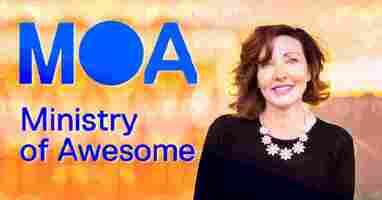24 hours ’til TNW2020: My thoughts before hosting our 15th flagship event
Boris is the wise ol’ CEO of TNW who writes a weekly column on everything about being an entrepreneur in tech — from managing stress to embracing awkwardness. You can get his musings straight to your inbox by signing up for his newsletter!

Tomorrow I’m hosting the 15th edition of our yearly flagship event, TNW2020 .
For every previous edition we’ve done, hosting meant being there in person, opening the conference with a show and welcome talk, and then walking around to shake hands with as many guests as possible. This year is different, but I’ll still be doing all of that — only now it’s online and virtual.
And the good thing about being online is you can still sign up for a free ticket and join me tomorrow — no need to book a last minute flight to Amsterdam. Send me a DM through the platform as soon as you’re in so we can chat!
Whenever I open a conference, I try to get the audience into a certain mood, or mindset, to help them get the most out of the event. I’ll talk about how much love and attention every speaker will put into their talks. But also how important it is to have those serendipitous meetings that events like these are famous for.
So in addition to thanking the crew and welcoming guests, I usually tell a story that helps put things into perspective. One year, I talked about taking risks. I quoted Grace Hopper: “it’s easier to ask for forgiveness than it is to get permission.”
My point wasn’t for the audience to start stealing drinks and apologize later, but to emphasize that rules and habits can limit your thinking. Sometimes, it’s good to let go of your preconceptions and try to look at the world from a different perspective. And what better place to start doing that than at this conference?
A few hours later, as I was making the rounds in the conference area, I bumped into my 10-year-old daughter.
I was surprised to see her because she wasn’t supposed to be at the conference at all, but at school. In fact, she had pleaded with me to take her to the conference, but I had told her she had to go to school, and that was final.
I asked her what happened and why she was here and not at school. She shrugged and said, “I really wanted to be here, so I decided to skip school. I know you wouldn’t allow that, but apparently, it is better to ask for forgiveness than permission.”
If only I could’ve seen my own face at that moment. It would’ve shown a weird combination of anger, frustration, and paternal pride, all at once.
Tomorrow I’ll open our flagship event once again, and I’ll close it on Friday. In between those two moments, I’ll be manning the helpdesk, and chatting to speakers and partners, and hopefully you… and probably my own kids, who are supposed to be in school tomorrow.
Can’t get enough of Boris? Check out his older stories here , and sign up for TNW’s newsletters here .
‘Chief Awesome Officer’ is an actual job title — suck it, CEOs
There’s a ton of ridiculous job titles in the startup scene, but usually, they’re somewhat transparent. Surely a Chief Meeting Designer must do something related to meetings and a Senior Clubhouse Executive probably spends all their time yapping on Clubhouse.

So that’s why I was a little stumped when I came across Marian Johnson — a Chief Awesome Officer . Does she just go around… being awesome? Why would you pay someone for that? What the hell does a Chief Awesome Officer do?!
“Well, the first thing about being Chief Awesome Officer is that every time I introduce myself, there’s a round of laughter,” Johnson explains when I call her up to bombard her with questions about her title.
“This might actually be the strength of the title,” Johnson says. She tells me it helps get people’s attention and makes her and the organization more approachable by not taking themselves too seriously.


Marian Johnson heads the Ministry of Awesome — yup, that’s the name — a starting point for entrepreneurs, startups, and innovators in Christchurch, New Zealand. Basically, it’s an independent not-for-profit startup hub dedicated to growing the ecosystem in the country by providing entrepreneurs with the tools they need to grow their ideas.
“The title is also meant to show we’re zero BS… although I suppose Chief Awesome Officer could sound super BS-y, but I think we’re the opposite,” Johnson adds and laughs. “We’re basically making fun of ourselves with stupid titles.”
This bullshit/non-bullshit method of breaking the ice with a ridiculous title is actually quite effective and has a surprisingly deep backstory.
Back from the ashes
On February 22, 2011, as the people of Christchurch were just finishing their lunch breaks, a 6.3-magnitude earthquake struck the city. Most of the city center was reduced to rubble in the intense quake, 185 people lost their lives, and thousands of people were made homeless.
“The inner city was completely flattened. Any building that didn’t fall down on that day was then taken down later. We lived in a donut outside the city center for a solid five years,” says Johnson.
In the aftermath of the earthquake, many were forced to move away from Christchurch and its population dropped considerably for a while. But the people of Christchurch were determined to rebuild their city and revitalize the community.
It was in this atmosphere that the Ministry of Awesome (MoA) was founded. The informalness of the name and its supercharged positivity was meant to jumpstart the startup ecosystem in a city reeling from a natural disaster.
Although construction is still ongoing , Christchurch is bustling again. When Johnson took over the MoA in 2017, the organization pivoted from earthquake recovery to building a more robust startup ecosystem across the country.
Currently, the MoA has 24 high-growth startups in its incubator program and numerous external innovation engines where Johnson and her team connect corporates with startups to solve the problems they face.
Ok, good to have an over-the-top job title after a crisis — how about now?
“I did think for a moment about changing the title,” Johnson admits. “When I saw the job title ‘Chief Awesome Officer’ it just made me think of all those stupid job titles at Google and I didn’t take it seriously at all “
Johnson could’ve played it safe (AKA boring ) and changed it to CEO to appear more serious to the conservative organizations she’d have to work with, like banks and governments. But in the end, she decided to keep the title because of its rich history — and its effectiveness.
She says the title lays a lot of the groundwork for her. Before she enters a room as a Chief Awesome Officer, people already know what to expect from her and what she’s about.
“The title and the name of the organization shows founders that whatever their moonshot idea or crazy dream, here’s one organization who’s ready to get behind you.”
The secret to being a Chief Awesome Officer
We’ve established that despite sounding like startup nonsense at first, the title actually brings a lot of value to the organization’s bottom line. But what makes a good Chief Awesome Officer?
Johnson thinks it all comes down to being an incredibly positive and energetic person, mixed with commercial sense and evangelist skills. Oh, and “you have to say ‘awesome’ a lot,” she adds.
“Yes, and weirdly, each of us… oh, I don’t know if this is good or bad, maybe I shouldn’t mention it? But we’ve all been American, which is strange,” Johnson says and laughs.
Got any weird jargon job titles at your startup that actually kinda make sense? Let us know at [email protected] !
Digital marketers need to be constantly ‘plugged in’ — which is risky during the pandemic
Did you know TNW Conference has a track fully dedicated to exploring how technology will shape the ever-evolving marketing landscape this year? Check out the full ‘ Rebrand ‘ program here.

I can’t speak for the entire digital community, but I can share my observations as well as the perspective of many I know in the industry. I hope this helps others who are feeling the same way. Many of us are uniquely attuned to news and social media updates. During a crisis, this is heightened. We have awareness on steroids.
Productivity > fear
I can’t stop consuming, feeding off every blog I find. Twitter, TikTok, Facebook, Instagram, YouTube, and LinkedIn.
I absorb all the content I can find. My brain won’t stop, won’t pause during a crisis of this scale. The sad thing is it feels like my coping mechanism. The idea of quiet stillness doesn’t sound peaceful. It sounds like an opportunity for ever-increasing dread to live. Alone with my thoughts gives my imagination free rein to imagine the worst.
Staying busy has steadied my thoughts towards what I can control instead of opening myself up to the total helplessness one can feel. It’s as if my brain has chosen productivity to drown out my fear.
It’s as if the more knowledge, data, and news I consume, the more control I will have. Knowledge is power. Knowledge will save us. And so my sponge keeps absorbing.
If the only way my type A personality can mentally survive lockdown, bad news, and homeschooling my kids, I guess this is where we are.
How do you unplug when you’re paid to be in the know?
Right now, many of my marketing colleagues and friends are slammed, doing more work than ever before as we try to navigate an unprecedented situation. We plan content, scrap content, perform sentiment checks, and social listening, all while being the voice of reason for brands and clients. In addition to the news and our findings, we have to know how the news will not only impact our content but the distribution channels we are using and building ads.
It isn’t enough to know what happened last week. I need to know what’s happened in the previous 24 hours and be able to figure out if and how it impacts my work and my clients.
For many of us digital marketers, we can’t unplug. Our work lives on our laptops and phones. We are paid to be plugged in, and it’s even more critical during a crisis. While a month ago, brands were able to assess brand sentiment around announcements and press releases quickly, now many brands are having to calculate where they stand on an hourly basis.
Does the stock market’s volatility impact the brand? Are any of the brand’s employees positive for COVID-19? Is the brand being asked for donations or to take action in some way? The answers are ever-evolving, and digital marketers are on the digital frontline of the public’s reactions and demands.
Many of us marketers are already in a heightened awareness of content. We can’t help but scroll through channels and ads, immediately judging the effectiveness and whether or not it’s currently tone-deaf in today’s more sensitive climate.
How can we cope?
What do you do when you can’t walk away?
Curate. Curate. Curate. You are what you consume. You can’t avoid all the negative content, but you can mute, block, or create Twitter lists specifically for the people you want to see. This is one way to ensure that when you are using platforms like Twitter for up-to-date news, you can quickly filter out the extraneous content. It creates a focused feed experience based on what you want to know about.
For Instagram and Facebook, don’t be afraid to unfollow or unfriend people if their content does not serve you what you need. It’s OK to close the door on people who are sharing misinformation or being passive-aggressive or hateful during this time. If your brain won’t stop eating everything it sees on the Internet, put it on a diet.
Use social media for entertainment. TikTok has become an oasis for entertaining and silly content. From doctors sharing information, quarantine stories, and a mix of challenges and funny content, it is a haven of distraction. A way to still be able to find content but with quick bursts. When in doubt, head to #dogsoftiktok. It’s the ultimate pick-me-up.
Vent. Get the poison out. We are stuck at home, trying to work, homeschool our kids, and watch as the world struggles to find answers and solutions. We need more than video conferences right now. That helps, but it isn’t enough. Just like we feel trapped at home, we also feel like our feelings about what is happening are and need to be trapped within us.
We don’t want to come across as someone panicking or vulnerable. We want to come across as strong, and so we bottle up our fear, our sadness, our grief, and try to fill our day with enough things to do that we don’t have the time to let all of that negativity pour out of us.
But we need to. We need to write it down or talk to a friend or family member. We need to purge that sadness and trauma out of us. We need to grieve in our own way and find out what we need to heal right now.
As marketers, we need to know the best steps to take for brands confidently, but we also need to give ourselves the grace of being OK with admitting that we don’t have all the answers — because we don’t. We are relying on empathy, trusting our instincts, and taking things a day at a time. We are collectively working to help our clients survive this crisis, but we also need to make sure that we do what it takes to ensure we don’t burn out from the added everything.
If you are reading this, I hope you and your loved ones stay safe. I hope we all make it to the other side as better humans and better marketers. I wish you a place to pour all the negativity you have out of you. You are not alone in feeling sad, feeling dread, in feeling lost sometimes. This community is here for you.
This article was originally written by Christina Garnet for Better Marketing , a publication providing advice that works and covering digital and social media marketing, tools, and case studies.